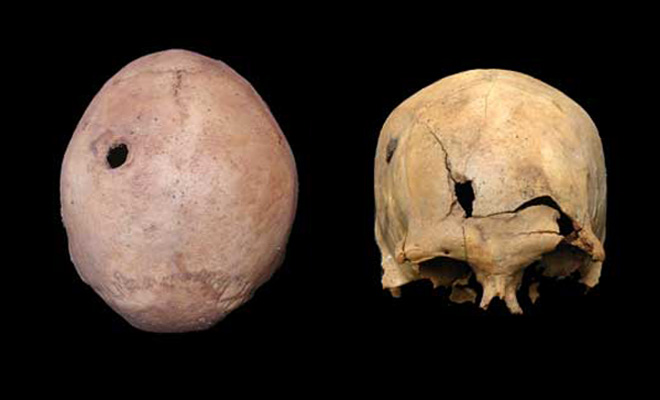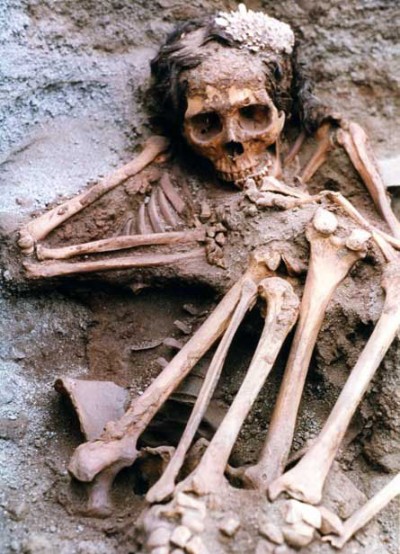Inca Burial Ground Shows Evidence of Spanish Conquest
posted on April 6th, 2010 in Andes Mountains, Archaeology, Incas, Peru, Recent Discoveries
Inca Skeletons Show Evidence of Spanish Brutality
Science News
April 2, 2010
If bones could scream, a bloodcurdling din would be reverberating through a 500-year-old cemetery in Peru. Human skeletons unearthed there have yielded the first direct evidence of Inca fatalities caused by Spanish conquerors…
European newcomers killed some Inca individuals with guns, steel lances or hammers, and possibly light cannons, scientists report online in the March 23 American Journal of Physical Anthropology.
Surprisingly, though, no incisions or other marks characteristic of sword injuries appear on these bones, according to a team led by anthropologist Melissa Murphy of the University of Wyoming in Laramie. Spanish documents from the 16th century emphasize steel swords as a favored military weapon.
Many Spaniards who helped Francisco Pizarro conquer the Incas were fortune-seekers, not soldiers, “so the absence of sword injuries makes some sense,” Murphy explains.
Skeletons in the Inca cemetery, as well as at another grave site about a mile away, display a gruesome array of violent injuries, many probably caused by maces, clubs and other Inca weapons, the researchers report. Those weapons may have been wielded by Inca from communities known to have collaborated with the Spanish, or might have been borrowed by the Spanish, they posit. “The nature and pattern of these skeletal injuries were unlike anything colleagues and I had seen before,” Murphy says. “Many of these people died brutal, horrible deaths.”
Little is known about early European dealings with the Inca, remarks anthropologist Haagen Klaus of Utah Valley University in Orem.
“Murphy’s data show the types of violence that emerged from the first moments of contact between Spaniards and the Inca,” Klaus says. Pottery and artifacts at the sites date to between 1470 and 1540, placing the deaths close to when Spaniards captured the Inca emperor around 1532. It took the invaders nearly another 40 years to control all Inca lands.
Murphy’s team assessed skeletons of 258 Inca individuals, age 15 or older, excavated several years ago at the two cemeteries.
In one cemetery, bodies had been hastily deposited in shallow graves. One-quarter of 120 skeletons displayed head and body injuries inflicted at the time of death, as indicated by a lack of healed bone and other clues. That’s a conservative estimate, Murphy notes, since soft-tissue damage doesn’t show up on bones.
“I’m struck by the severity of violence in certain individual cases, where the skull was essentially crushed, repeatedly stabbed or struck, or shot through by gunshot,” comments archaeologist Steven Wernke of Vanderbilt University in Nashville. Whoever killed these individuals wanted to intimidate survivors as well, he asserts.
One man’s skull contained two holes and radiating fractures consistent with damage produced by early guns that shot ammunition at low velocities.
Another male skull sported three small rectangular openings in the back of the head. These injuries resemble those on skulls from a 1461 battlefield cemetery in England, Murphy says. Medieval weapons tipped with steel spikes or sharp beaks probably caused these wounds, she proposes.
Three other skeletons exhibited injuries likely due to Spanish weapons. Other skeletons contained head and body fractures probably inflicted by attackers bearing Inca weapons.
Individuals placed in this cemetery may have been slain in a documented 1536 Inca uprising against Spanish rulers in nearby Lima, Murphy suggests. Family members collected their bodies and buried them quickly near previously deceased relatives, she speculates.
At the second Inca cemetery, 18 of 138 skeletons showed definite signs of violent death, all from Inca weapons. That supports a scenario in which social turmoil around the time Spaniards arrived triggered conflicts between Inca communities, Murphy says.


